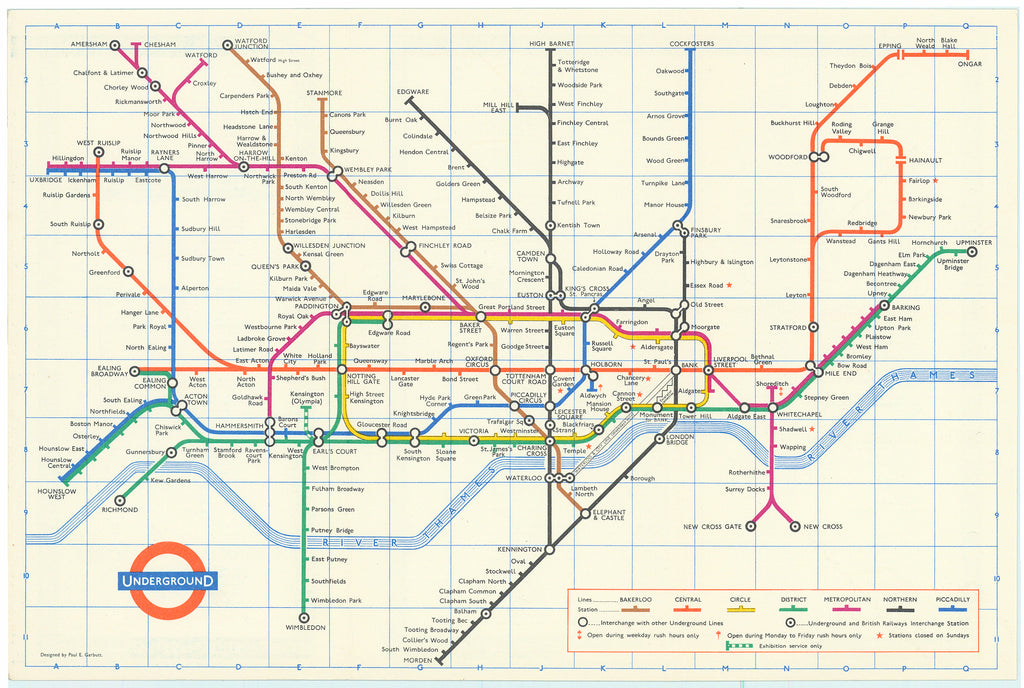- Title: Underground Diagram of Lines and Station Index
- Author: Harry Beck
- Date: 1964
- Condition: See description
- Inches: 8 1/2 x 5 1/2 [Image]
- Centimeters: 21.59 x 13.97 [Image]
- Product ID: 308225
Harry Beck's Reductionist Modern Masterpiece
Originally considered too radical, Harry Beck's London Underground Tube map has become a design classic. Now recognized across the world, the Tube map was originally the brainchild of Underground electrical draughtsman, Harry Beck, who produced this imaginative and beautifully simple design back in 1933. Rather than emphasizing distance and geographical accuracy, like other maps, Beck based his on the circuit diagrams he drew for his day job; stripping the sprawling Tube network down to a neat diagram of colored, crisscrossing lines.
Beck's map was initially rejected by the publicity department because it was considered too radical, but a successful trial print-run showed that it was just what the public wanted. The result was an instantly clear and comprehensible chart that would become an essential guide to London - and a template for transport maps the world over.
This 1964 edition includes a grid overlay keyed to a reference table on the verso with nearly 200 locations, stations, landmarks, and cities identified.
Beck's revolutionary design, with certain modifications and additions, survives to the present day and is set to serve London Underground and its millions of customers for many years to come.
Background on Creator
Harry Beck was an eminent twentieth century English technical draftsman. He designed the iconic topological map of London’s Underground subway system (now Tube) and attained recognition posthumously. It was Beck’s innovative idea that divorced the notoriously convoluted geography from his map design. At that time, the idea was alien to authorities and for its rather radical nature the initial design was rejected after being submitted to Frank Pick of London Underground, in 1931.
Beck assumed that passengers riding the Tube were not as much concerned about geographical accuracy as they were interested in finding their way out from one station to another. While working at an electrical circuit diagram, he came up with this ingenious idea of prioritizing the map outlining the subway system itself rather than accurately mentioning the distance. Even though it was rejected by the publicity department, Beck’s perseverance culminated in a successful trial of 500 copies which was distributed at a select few stations, in 1932. The following year, the map was given its first full publication, printing seven hundred thousand copies.
Beck rationally mapped out what Tube passengers required to navigate easily without being lost in distance and measurements. He found the answer in exploring how the various tube stations and rail lines were connected with one another. He applied the Modernist grid system upon the city by eliminating all rail lines and added minimal vocabulary of symbols ingrained with bright colors. The end product was a quintessential work of twentieth century information design.
Over the thirty years, Harry Beck consistently updated and revised his original London Underground map. However, from 1960 onwards his contributions were decidedly unwelcome as the newly hired publicity manager for the London Underground took over. Beck was neither paid considerably nor properly recognized for his seminal work until he passed away in 1974. Although Beck couldn’t enjoy fame and status in his lifetime, his work became a legacy for the map designers to come who would take inspiration from his vision, mapping a staggering array of transport systems.
References:
London Transport Museum, British Library, both on-line and accessed 10-27-2023.
Condition
Shows limited evidence of handling, very lightly age toned. Excellent.



